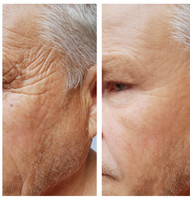Solar Elastosis & Actinic Elastosis And How to Treat
Posted by kelly ozmon on 08-17-2022
Solar elastosis is characterized by thick, yellowed skin that sometimes appears furrowed, creased, or bumpy. It is seen in people who have experienced long-term sun exposure over many years and is a type of photoaging. The sun's UV rays break down the collagen and elastic fibers in your skin, causing the skin to lose its strength, flexibility and structural support. Because it is primarily caused by UV damage, solar elastosis is most commonly seen on areas of the body that are exposed to the sun, such as the face, neck, and arms.
Baumann Cosmetic Dermatology
The key ingredients and products for treating Actinic Elastosis:
Retinoids - Miracle Creme With Retinol or Rectify+ Retinol & Retinoate Serum
Rectifying Glycolic Acid
Topical Alpha Hydroxy Acids (AHAs) given as 10% solution three times a week, building up to 15% and 20% if tolerated. Stinging sensations may be reported, as may peeling and flaking, itching and dryness.
Tip: Applying Pro-Skin Brighten & Inhibit Complex / Kojic Acid 2% prior to Rectifying Glycolic Acid will improve results.
Retin - A 0.025% - 0.05%
Topical application of retinoids, usually 0.025% at the beginning and building up to 0.05% for thicker skin, is performed every evening. The highest possible concentration in this condition is 0.1%.
Tip: Alternating Retin A 2-4 nights with Rectifying Glycolic Acid for accelerating results
Antioxidants - Exceptionelle C Serum 20% with Ferulic and/or Am Cream Plump Skin a Collagen
Resveratrol - Coming soon
Collagen Supplements
Stem Cells - GD11 Ampoule Serum
Epidermal Growth Factors - Miracle Creme with Retinol or Neuropeptide a Growth Factor Serum
Pro-Skin Brighten & Inhibit Complex | Kojic Acid 2%
Antioxidants - Exceptionelle C Serum 20% with Ferulic and/or Am Cream Plump Skin a Collagen, Pro-Skin Brighten & Inhibit Complex 2% Kojic

